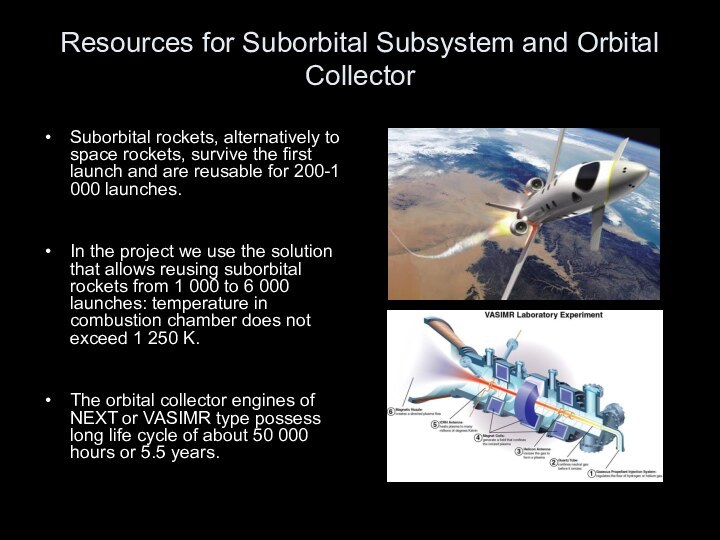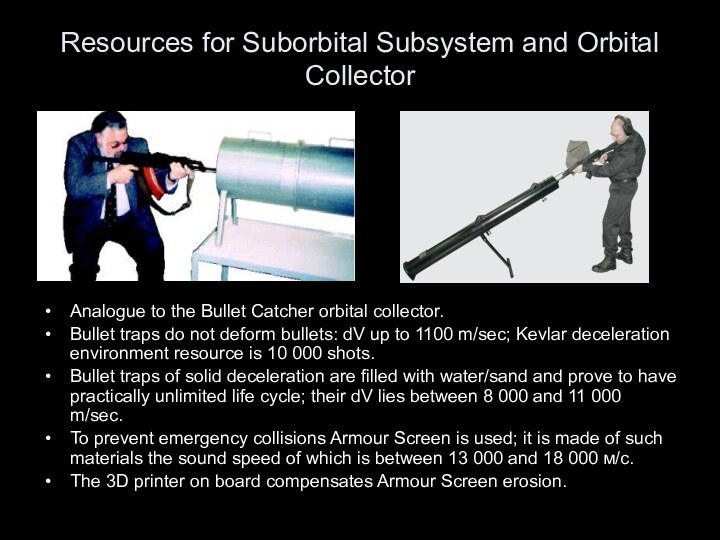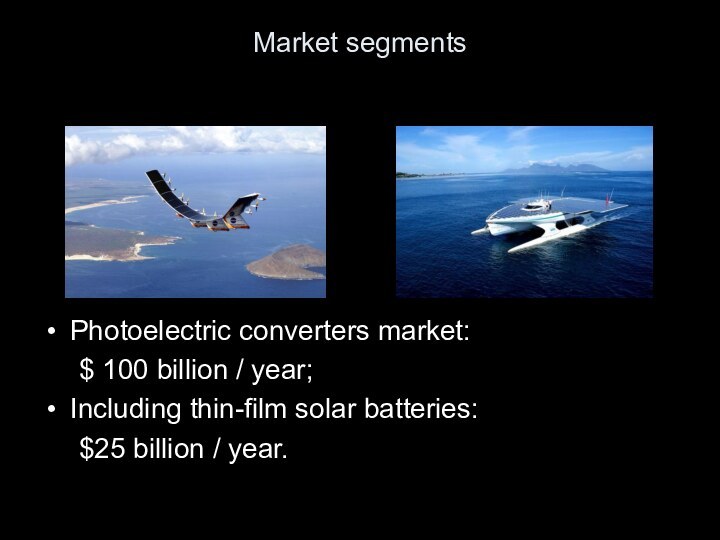Слайд 2
Space Cargoes Delivery Problems
Prices to deliver cargo into
space are high. The cost of satellite launching to
geostationary orbit (GEO) amounts to $50 000 USD/kg.
It is necessary for business development of space to reduce prices to 5-10% of current ones.
Слайд 3
Space Cargoes Delivery Problems
To reduce prices it is
essential for the planet protection from various space menaces.
Слайд 4
Market Prospects
Launching services market is growing. In 2013
the make size reached $5.4 billon*.
In case of unit
cost reduction by 10 times, annual profits of launching companies will amount to $ 5 billion.
*) According to Satellite Industry Association (SIA) information on telecommunication, space and satellite industries revenues between 2001 and 2013.
Слайд 5
General Direction to Solve the Problem
Attempts to solve
the problem are aspirations to create reusable space vehicles
and to reduce prices by decreasing spacecraft depreciation & amortization expenses.
Unfortunately, such projects are long overdue; and single use rockets (expendable spacecraft) are still being launched.
Слайд 6
Solution
The ORBITRON Project solves the problem of reusable
space vehicles creation.
Слайд 7
Solution
The prototype project is an US patent (US4775120
& US5199671), unimplemented because of the spacecraft huge mass
of 40 000 tons.
Слайд 8
Solution
The solution we propose reduces the mass of
the American prototype to feasible.
Слайд 9
Orbitron, Orbital Substance Collector (OSC)
The developed space vehicle
system consists of two parts:
The first part is an
aerospace (land based) part based on suborbital rockets;
The second part is an orbital cargo satellite collector.
Cargo is hoisted by suborbital rockets and then is ejected in front of the orbital collector.
As a result of shock collision inside the collector, the portion of cargo accelerates up to the speed of the collector itself.
After its kinetic energy is restored, the collector receives the next portion of cargo.
Слайд 10
Orbitron, Orbital Substance Collector (OSC)
The developed spacecraft differs
from the American prototype in the way cargo portions
arrive into the collector gradually not simultaneously as a whole like in the prototype.
To achieve this, Mylar film 2 micron thick and up to 8 000 meters long covered with special substances is used.
As a result, shock impact on the collector is diminished and its mass can be reduced from 40 000 tons to 1-4 tons.
Слайд 11
Orbitron, Orbital Substance Collector (OSC)
Planet-Orbit basic model for
the Earth.
Planet-Orbit basic model for the Moon
Слайд 12
Orbitron, Orbital Substance Collector (OSC)
Additional model
Orbit-Orbit
Слайд 13
Earth-Orbit System
Basic model of the Earth-Orbit system: dV=8
000 m/sec.
Starting mass of suborbital rocket: 1 000 kg.
Orbital
collector mass: 3 600 kg.
Electric capacity of the collector: 0.5 MW
Annual cargo traffic: 29 000 kg.
Launch pad and reusable space vehucle cost: $ 2 million per unit.
Orbital collector cost: $ 36 million.
The cost of the set of one collector and two launch pads: $ 40 million.
Unit delivery cost: $ 600 / kg.
Слайд 14
Orbit-Orbit System
Additional model of the Orbit-Orbit system: dV=2
000 m/sec.
Orbital collector mass: 1 000 kg.
Electric capacity of
the engine system: 0.01 MW (!)
Annual cargo traffic: 11 000 kg.
Orbital collector cost: $ 10 million.
Unit delivery cost: $ 180 / kg plus the cost of delivery to LEO.
Economic effect: price reduction for delivery from LEO to geotransitional orbit from
$ 10 000 -20 000 to $ 180 / kg.
Слайд 15
Non-Rocket Atmosphere-Orbit System
Two-collector system on prograde and retrograde
(reverse) orbits that exchange cargoes for periodic submerging into
dense atmosphere.
Total mass of the two orbital collectors: 3 600 kg.
Electric capacity of the collector engine unit: 0.5 MW
Annual cargo traffic: 15 000 kg /year.
Life cycle: 5 years.
Orbital collector set cost: $ 36 million.
Unit cost to collect atmospheric oxygen and nitrogen: $ 500 / kg.
Слайд 16
Non-Rocket Atmosphere-Orbit System»
Слайд 17
Moon-Orbit System
Basic model of the Moon-Orbit system: dV=1
680 m/sec.
Mechanical catapult mass: 200 kg.
Orbital collector mass: 1
800 kg.
Electric capacity of the collector: 0.03 MW
Magnesium and calcium usage in electric propulsion motor: 1 000 kg / year.
Annual cargo traffic: 29 000 kg /year (3 000 captures by 10 kg portion).
Launcher cost: $ 20 million per unit.
Orbital collector cost: $ 90 million.
The cost of the set of one collector and two launch pads and two catapults:
$ 130 million.
Unit delivery cost: $ 900 / kg.
Слайд 18
Orbit-Moon System
Mass-dimensions characteristics of American prototype and the
new developed moon collector for high-speed substance flows.
Слайд 19
Orbit-Moon System
Absorbed substance flow speed: dV=1680…3000 m/sec.
Substance flow
forms: Mylar bands coated with solid substances and kapton
tubes with liquid substances.
Absorbed cargoes: carbon, hydrogen, nitrogen, chlorine, fluoride, oxygen, potassium, aluminum compounds, etc.
Per-second substance inflow: 10 kg / sec.
Collector working resource: about 3 hours (10 000 seconds).
Dry mass of the stationary collector – 1 000 kg.
Cargo mass intake throughout the life cycle – 100 000 kg (10 000 captures by portions of 10 kg each).
Cost of stationary collector: $ 10 million.
Unit cost to deliver cargoes: $ 1 000 / kg
Economic efficiency: price reduction for delivery from low lunar orbit to the Moon surface from $20 000 – 50 000 / kg to $ 1 000 / kg.
When earth hydrogen is used to produce regolith rocket fuel, its cost at the base will be $6000 / kg (excluding the cost of technical blocks’ depreciation & amortization).
Слайд 20
Moon-Earth System
Orbitron Moon and Earth joined systems use
potential and kinetic energy stocks of the Earth and
the Moon. The energy is produced by active gravitation maneuver (Oberth effect).
Слайд 21
Resources for Suborbital Subsystem and Orbital Collector
Suborbital rockets,
alternatively to space rockets, survive the first launch and
are reusable for 200-1 000 launches.
In the project we use the solution that allows reusing suborbital rockets from 1 000 to 6 000 launches: temperature in combustion chamber does not exceed 1 250 K.
The orbital collector engines of NEXT or VASIMR type possess long life cycle of about 50 000 hours or 5.5 years.
Слайд 22
Resources for Suborbital Subsystem and Orbital Collector
Heat protection
of rocket stages excluding its first stage is executed
similar to that of X-20 Dyna-Soar rocketplane with radiative cooling made of refractory metals and alloys (molybdenum, zirconium, rhenium-niobium alloy Rene 41) without ablation or heat-absorbing ceramic coating.
This type of heat protection ensures minimal time for its routine maintenance after the landing of suborbital rocket and its long life cycle.
Due to the extended repair interval for heat protection and the engine, the launch frequency for the suborbital rocket is from four to eight launches per day.
Слайд 23
Resources for Suborbital Subsystem and Orbital Collector
Analogue to
the Bullet Catcher orbital collector.
Bullet traps do not deform
bullets: dV up to 1100 m/sec; Kevlar deceleration environment resource is 10 000 shots.
Bullet traps of solid deceleration are filled with water/sand and prove to have practically unlimited life cycle; their dV lies between 8 000 and 11 000 m/sec.
To prevent emergency collisions Armour Screen is used; it is made of such materials the sound speed of which is between 13 000 and 18 000 м/с.
The 3D printer on board compensates Armour Screen erosion.
Слайд 24
Types of Cargoes
The collector can receive cargoes of
only raw material type that are not destroyed by
impact acceleration.
However, most cargoes delivered into space are not spacecraft but rocket fuel to set them into the final orbit.
Up to 80% of the spacecraft’s weigh is the mass of its fuel. Therefore, the proposed space vehicle system will have many types of cargoes.
Слайд 25
Types of Cargoes
In addition to fuel, such substances
as aluminum, titanium, carbon, silicon and other necessary substances
are to be transported into space to produce spare parts and units for spacecraft in the framework of AMAZE program.
European Space Agency (ESA) has launched AMAZE program to apply 3D printing technology for production of metallic parts and units for spacecraft, airplanes and thermonuclear reactors;
ESA has invested about € 20 million into R&D to create AMAZE 3D Printing Technology.
Слайд 26
Orbitron Technology Business Opportunities
The technology implementation allows its
users to create:
A chain of space fueling stations to
fuel inter-orbital boosters and tugs;
A chain of orbital platforms with 3D printers to produce spare parts and units for spacecraft.
Слайд 27
Patents
Method and system for delivering cargoes into space.
US 8882047 B2.
Status: Grant of patent is intended
Method
for delivering cargoes into space and a system for implementation of same. EP2390188
Status: Grant of patent is intended (Great Britain, Germany, France).
Способ доставки грузов в космос и система его осуществления. Patent of Russia RU2398717
Способ доставки грузов в космос и система его осуществления. Patent of Eurasia Patent Organization 017577
Спосіб доставки вантажів в космос і система його здійснення. Patent of the Ukraine 99230
Способ энергообеспечения космических аппаратов-накопителей. Patent of Russia RU2451631
Energy supply method for spacecrafts-accumulators. Patent application pending US 2013/0233974 A1
Method and system for feeding jet engines. Patent application pending US 2014/0326832 A1
Слайд 30
Sales and Marketing
Estimated revenue for licensees and franchisees
when trading the following goods (in USD per year):
Rocket
fuel of 300 tons: $0.9 billion/year;
Technological materials of 100 tons: $0.3 billion/year;
Semiconductors of 400 tons: $1.2 billion/year.
Investors’ Revenue:
License vending in the USA, EU and Russia;
Franchising in “space club” countries;
Royalties;
Founder’s profit when a joint stock company is created after seed investment stage is over.
Слайд 31
Market segments
Launch Services market: $ 5 billion /
year;
Spacecraft and satellites production market, spacecraft being produced on
the orbit using AMAZE program: $16 billion/year
Слайд 32
Market segments
Photoelectric converters market:
$ 100 billion /
year;
Including thin-film solar batteries:
$25 billion / year.
Слайд 33
Market segments
Raw material supply market for satellite solar
power station construction in the framework of the Japanese
Solarbird program: $24 billion.
Слайд 34
Market segments
Material delivery market to construct and maintain
Lunar Base in the framework of the Russian program
(patents granted until 2030):
Construction: $ 40 billion
Supplies to the base: $ 4-15 billion / year.
Слайд 35
Competitors
Shackleton Energy Company, USA, working on water-production technologies
on the Moon to produce oxygen and hydrogen to
sell them via orbital fueling stations.
PHARO start-up, USA, developing PROFAC system with laser energy drive to collect atmospheric oxygen in order to produce fuel for space fueling stations.
Слайд 36
Potential Partners
Planetary Resources
Deep Space Industries
SpaceX
Bigelow Aerospace
Boeing Company
EADS Astrium
MDA
Mitsubishi Corp.
Shimizu
Corp.
TSNIIMASH (Central Scientific Research Institute of Machine Building): orbital space vehicle air collectors and frameless solar batteries
Institute for Space Research of the Academy of Sciences: Spacecraft mathematic models
United Institute а High Temperatures: Mathematic models for shock and impact processes
Слайд 37
Potential Partners
Institute of Semiconductor Physics of Siberian
Department of Russian Academy of Sciences and Russian Space
Agency: ОКА-Т technological module
Moscow State Technical University named after N.E. Bauman: EDTS cable electric engine
State Space Research and Production Center named after M. Khrunichev: MRKC-1 suborbital demonstrator
Design Engineering Department for Chemical Automation: YARD Thermal-chemical simulator /Nuclear thermal rocket /
State Scientific Center named after Keldysh: heating exchange hydrogen engine unit for solar heat rocket engine
Lin Industrial Company: suborbital mini launch rockets
Слайд 38
Team
Ideal of the Project:
Alexander Mayboroda
Project Manager:
Vladimir Megel
Leading Specialists:
D.K. Dragun, V.M. Melnikov, O.P. Pchelyakov, V.I. Florov
Main participants and their skills: the team has ten specialists with necessary qualifications, knowledge and experience. Among them, there are specialists of TSNIIMASH, Vympel Design Engineering Department, Moscow State Technical University named after N.E. Bauman, Institute for Space Research of the Academy of Sciences, Institute of Semiconductor Physics of Siberian Department of Russian Academy of Sciences, Sputniks Company.
Слайд 40
R&D First Stage Investment
Stages of the working
process:
Conceptual Design Studies;
Computer Simulation of the Processes;
Collector Demo Model
Creation, its bed testing, follow-up revision;
Production of collector in micro-satellite version for orbital tests (dV=1400-2000 m/sec), follow-up revision;
Resources required: 40 million rubles (including 10 million rubles from a private investor and 30 million rubles from Scolkovo Fund)
First stage lasts for two years.
Keeping the US and EU patents and completion of new patents obtaining process require:
$ 11 000 in 2015;
$ 5 000 in 2016.
Слайд 41
Summary and Contacts
The developed system ensures radical cost
decrease for space cargoes delivery.
Cost efficiency provides extra profit
in the sphere of raw material space cargoes delivery to orbital spacecraft.
We are looking for commercial partners and investors to continue the project.
AVANTA Consulting welcomes you to collaborate in commercialization of Orbitron Project.
Address: 150 Bolshaya Sadovaya Street, suite 909, Rostov-on-Don, 344000, Russia.
Ph.: +7 (863) 221 73 71; +7 (863) 263 32 94
Email: mayboro@gmail.com
URL: www.mayboroda.com
Thank you for your attention
Your questions are welcome













































